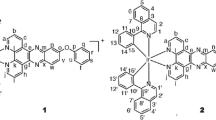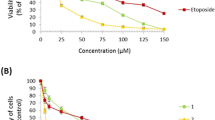Abstract
A series of novel dinuclear platinum complexes based on the bisphosphonate ligands have been synthesized and characterized in our recent study. For the purpose of discovering the pharmacology and action mechanisms of this kind of compounds, the most potent compound [Pt(en)]2ZL was selected for systematic investigation. In the present study, the inhibition effect on the human gastric cancer cell lines SGC7901 and action mechanism of [Pt(en)]2ZL were investigated. The traditional 3-[4,5-dimethyl-2-thiazolyl]-2,5-diphenyl-2-tetrazolium bromide (MTT) assay and colony formation assay were carried out to study the effect of [Pt(en)]2ZL on the cell viability and proliferation capacity, respectively. The senescence-associated β-galactosidase staining and immunofluorescence staining were also performed to assess the cell senescence and microtubule polymerization. Fluorescence staining and flow cytometry (FCM) were used to monitor the cell cycle distribution and apoptosis, and Western blot analysis was applied to examine the expression of several apoptosis-related proteins. The results demonstrated that [Pt(en)]2ZL exhibited remarkable cytotoxicity and anti-proliferative effects on the SGC7901 cells in a dose- and time-dependent manner, and it also induced cell senescence and abnormal microtubule assembly. The cell apoptosis and cell cycle arrest induced by [Pt(en)]2ZL were also observed with the fluorescence staining and FCM. The expressions of cell cycle regulators (p53, p21, cyclin D1, cyclin E, and cyclin-dependent kinase (CDK)2) and apoptosis-related proteins (Bcl-2, Bax, caspase-3, poly ADP ribose polymerase (PARP), and survivin) were regulated by the treatment of [Pt(en)]2ZL, resulting in the cell cycle arrest and apoptosis. Therefore, [Pt(en)]2ZL exerted anti-tumor effect on the gastric cancer via inducing cell cycle arrest at G1/S phase and apoptosis.








Similar content being viewed by others
References
Marano L, Chiari R, Fabozzi A, De Vita F, Boccardi V, Roviello G, et al. c-Met targeting in advanced gastric cancer: an open challenge. Cancer Lett. 2015;365:30–6.
Zhang XJ, Liu YG, Shi XJ, Chen XW, Zhou D, Zhu DJ. The prognostic role of neutrophils to lymphocytes ratio and platelet count in gastric cancer: a meta-analysis. Int J Surg. 2015;21:84–91.
Kim SM. Chemotherapy beyond second-line in advanced gastric cancer. World J Gastroenterol. 2015;21:8811.
Johnstone TC, Wilson JJ, Lippard SJ. Monofunctional and higher-valent platinum anticancer agents. Inorg Chem. 2013;52:12234–49.
Al-Jaroudi SS, Altaf M, Al-Saadi AA, Kawde AN, Altuwaijri S, Ahmad S, et al. Synthesis, characterization and theoretical calculations of (1,2-diaminocyclohexane) (1,3-diaminopropane)gold(III) chloride complexes: in vitro cytotoxic evaluations against human cancer cell lines. Biometals. 2015;28(5):827–44.
Qiu L, Lv G, Cao Y, Chen L, Yang H, Luo S, et al. Synthesis and biological evaluation of novel platinum complexes of imidazolyl-containing bisphosphonates as potential anticancer agents. J Biol Inorg Chem. 2015:1–13.
Portugal J, Bataller M, Mansilla S. Cell death pathways in response to antitumor therapy. Tumori. 2009;95:409–21.
Dikovskaya D, Cole John J, Mason Susan M, Nixon C, Karim Saadia A, McGarry L, et al. Mitotic stress is an integral part of the oncogene-induced senescence program that promotes multinucleation and cell cycle arrest. Cell Reprogram. 2015;12:1483–96.
Otsuka K, Ochiya T. Genetic networks lead and follow tumor development: microRNA regulation of cell cycle and apoptosis in the p53 pathways. Biomed Res Int. 2014;2014:749724.
Pflaum J, Schlosser S, Muller M. p53 family and cellular stress responses in cancer. Front Oncol. 2014;4:285–99.
Stein GS, van Wijnen AJ, Stein JL, Lian JB, Montecino M, Zaidi SK, et al. An architectural perspective of cell-cycle control at the G1/S phase cell-cycle transition. J Cell Physiol. 2006;209:706–10.
Russo A, Esposito D, Catillo M, Pietropaolo C, Crescenzi E, Russo G. Human rpL3 induces G(1)/S arrest or apoptosis by modulating p21 (waf1/cip1) levels in a p53-independent manner. Cell Cycle. 2013;12:76–87.
Tian H, Gao Z, Li H, Zhang B, Wang G, Zhang Q, et al. DNA damage response—a double-edged sword in cancer prevention and cancer therapy. Cancer Lett. 2015;358:8–16.
Choi YJ, Anders L. Signaling through cyclin D-dependent kinases. Oncogene. 2014;33:1890–903.
Hwang HC, Clurman BE. Cyclin E in normal and neoplastic cell cycles. Oncogene. 2005;24:2776–86.
Wang H, Lu YT, Luo L, Li WS, Liang CF, He HY, et al. MicroRNA-195 inhibits the proliferation of human glioma cells by directly targeting cyclin D1 and cyclin E1. PLoS One. 2013;8, e54932.
Coqueret O. Linking cyclins to transcriptional control. Gene. 2002;299:35–55.
Mollazadeh S, Fazly Bazzaz BS, Kerachian MA. Role of apoptosis in pathogenesis and treatment of bone-related diseases. J Orthop Surg Res. 2015;10:15.
Rosado MM, Bennici E, Novelli F, Pioli C. Beyond DNA repair, the immunological role of PARP-1 and its siblings. Immunology. 2013;139:428–37.
Smulson ME, Simbulan-Rosenthal CM, Boulares AH, Yakovlev A, Stoica B, Iyer S, et al. Roles of poly(ADP-ribosyl)ation and PARP in apoptosis, DNA repair, genomic stability and functions of p53 and E2F-1. Adv Enzym Regul. 2000;40:183–215.
Hsiao CJ, Hsiao G, Chen WL, Wang SW, Chiang CP, Liu LY, et al. Cephalochromin induces G0/G1 cell cycle arrest and apoptosis in A549 human non-small-cell lung cancer cells by inflicting mitochondrial disruption. J Nat Prod. 2014;77:758–65.
Jiao Y, Ma S, Li J, Shan L, Wang Y, Tian M, et al. N-acetyl cysteine (NAC)-directed detoxification of methacryloxylethyl cetyl ammonium chloride (DMAE-CB). PLoS One. 2015;10, e0135815.
Qiu L, Lv G, Guo L, Chen L, Luo S, Zou M, et al. Synthesis, crystal structure and antitumor effect of a novel copper(II) complex bearing zoledronic acid derivative. Eur J Med Chem. 2015;89:42–50.
Qian C, Yao J, Wang J, Wang L, Xue M, Zhou T, et al. ERK1/2 inhibition enhances apoptosis induced by JAK2 silencing in human gastric cancer SGC7901 cells. Mol Cell Biochem. 2014;387:159–70.
Ji G, Liu K, Okuka M, Liu N, Liu L. Association of telomere instability with senescence of porcine cells. BMC Cell Biol. 2012;13:36.
Zuo D, Guo D, Jiang X, Guan Q, Qi H, Xu J, et al. 3-(3-Hydroxy-4-methoxyphenyl)-4-(3,4,5-trimethoxyphenyl)-1,2,5-selenadiazole (G-1103), a novel combretastatin A-4 analog, induces G2/M arrest and apoptosis by disrupting tubulin polymerization in human cervical HeLa cells and fibrosarcoma HT-1080 cells. Chem Biol Interact. 2015;227:7–17.
Lin KW, Huang AM, Lin CC, Chang CC, Hsu WC, Hour TC, et al. Anti-cancer effects of ursane triterpenoid as a single agent and in combination with cisplatin in bladder cancer. Eur J Pharmacol. 2014;740:742–51.
Wang C, Guo LB, Ma JY, Li YM, Liu HM. Establishment and characterization of a paclitaxel resistant human esophageal carcinoma cell line. Int J Oncol. 2013;43:1607–17.
Mc Gee MM. Targeting the mitotic catastrophe signaling pathway in cancer. Mediat Inflamm. 2015;2015:146282.
Castedo M, Perfettini JL, Roumier T, Andreau K, Medema R, Kroemer G. Cell death by mitotic catastrophe: a molecular definition. Oncogene. 2004;23:2825–37.
Vakifahmetoglu H, Olsson M, Zhivotovsky B. Death through a tragedy: mitotic catastrophe. Cell Death Differ. 2008;15:1153–62.
Mukhtar E, Adhami VM, Mukhtar H. Targeting microtubules by natural agents for cancer therapy. Mol Cancer Ther. 2014;13:275–84.
Chandrasekaran G, Tatrai P, Gergely F. Hitting the brakes: targeting microtubule motors in cancer. Br J Cancer. 2015;113:693–8.
Okada N, Sato M. Spatiotemporal regulation of nuclear transport machinery and microtubule organization. Cell. 2015;4:406–26.
Zhao P, Chen L, Li LH, Wei ZF, Tong B, Jia YG, et al. SC-III3, a novel scopoletin derivative, induces cytotoxicity in hepatocellular cancer cells through oxidative DNA damage and ataxia telangiectasia-mutated nuclear protein kinase activation. BMC Cancer. 2014;14:987.
Chen CY, Chen SY, Chen CH. Liriodenine induces G1/S cell cycle arrest in human colon cancer cells via nitric oxide- and p53-mediated pathway. Process Biochem. 2012;47:1460–8.
Menon VR, Peterson EJ, Valerie K, Farrell NP, Povirk LF. Ligand modulation of a dinuclear platinum compound leads to mechanistic differences in cell cycle progression and arrest. Biochem Pharmacol. 2013;86:1708–20.
Sun Z, Pan X, Zou Z, Ding Q, Wu G, Peng G. Increased SHP-1 expression results in radioresistance, inhibition of cellular senescence, and cell cycle redistribution in nasopharyngeal carcinoma cells. Radiat Oncol. 2015;10:152.
El Hasasna H, Athamneh K, Al Samri H, Karuvantevida N, Al Dhaheri Y, Hisaindee S, et al. Rhus coriaria induces senescence and autophagic cell death in breast cancer cells through a mechanism involving p38 and ERK1/2 activation. Sci Rep. 2015;5:13013.
Nordin N, Majid NA, Hashim NM, Rahman MA, Hassan Z, Ali HM. Liriodenine, an aporphine alkaloid from Enicosanthellum pulchrum, inhibits proliferation of human ovarian cancer cells through induction of apoptosis via the mitochondrial signaling pathway and blocking cell cycle progression. Drug Des Devel Ther. 2015;9:1437–48.
Paul A, Das S, Das J, Samadder A, Bishayee K, Sadhukhan R, et al. Diarylheptanoid-myricanone isolated from ethanolic extract of Myrica cerifera shows anticancer effects on HeLa and PC3 cell lines: signalling pathway and drug-DNA interaction. J Integr Med. 2013;11:405–15.
Li T, Zhang Q, Zhang J, Yang G, Shao Z, Luo J, et al. Fenofibrate induces apoptosis of triple-negative breast cancer cells via activation of NF-kappaB pathway. BMC Cancer. 2014;14:96.
Jia J, Yang M, Chen Y, Yuan H, Li J, Cui X, et al. Inducing apoptosis effect of caffeic acid 3,4-dihydroxy-phenethyl ester on the breast cancer cells. Tumour Biol. 2014;35:11781–9.
Pieper A. Poly (ADP-ribose) polymerase, nitric oxide and cell death. Trends Pharmacol Sci. 1999;20:171–81.
Li Q, Lu XH, Wang CD, Cai L, Lu JL, Wu JS, et al. Antiproliferative and apoptosis-inducing activity of schisandrin B against human glioma cells. Cancer Cell Int. 2015;15:12.
Liu W, Zhu F, Jiang Y, Sun D, Yang B, Yan H. siRNA targeting survivin inhibits the growth and enhances the chemosensitivity of hepatocellular carcinoma cells. Oncol Rep. 2013;29:1183–8.
Zhang J, Zhu Z, Sun Z, Sun X, Wang Z, Xu H. Survivin gene expression increases gastric cancer cell lymphatic metastasis by upregulating vascular endothelial growth factor-C expression levels. Mol Med Rep. 2014;9:600–6.
Acknowledgments
The authors are grateful to the financial support from National Natural Science Foundation of China (21371082 and 21501074), Natural Science Foundation of Jiangsu Province (BK20141102 and BK20151118), and Key Medical Talent Project of Jiangsu Province (RC2011097).
Author information
Authors and Affiliations
Corresponding authors
Electronic supplementary material
Below is the link to the electronic supplementary material.
ESM 1
(DOC 856 kb)
Rights and permissions
About this article
Cite this article
Yang, H., Qiu, L., Zhang, L. et al. Platinum-zoledronate complex blocks gastric cancer cell proliferation by inducing cell cycle arrest and apoptosis. Tumor Biol. 37, 10981–10992 (2016). https://doi.org/10.1007/s13277-016-4977-2
Received:
Accepted:
Published:
Issue Date:
DOI: https://doi.org/10.1007/s13277-016-4977-2




